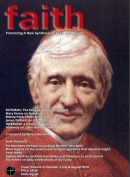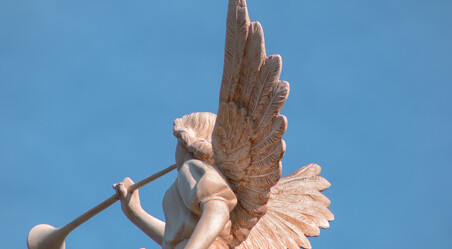The Incarnation, The Priesthood and Communion with God
John Gavin FAITH Magazine January-February 2008
We Shall Become Like Him
One of the “hot topics” in Patristic studies these days i s theosiso r deificatio. Dionysius the Areopogite defines theosis as “the attaining of likeness to God and union with him in so far as it is possible”[1]. Long considered to be primarily an Eastern doctrine, overlooked by the West in its emphasis upon redemption in Christ, deificatiohas become the focus of many contemporary readings of such Western Fathers as Augustine of Hippo, Hilary of Poitiers, and Ambrose of Milan. Thus we find these remarkable words in Augustine’s homily on Psalm 49, regarding the elevation of the human to the divine in Jesus Christ:
of the one begetting.[2]
Union and Communion, the Purpose of The Incarnation
For Christianity, however, the dangers inherent to deificatioare obviated by the doctrine of the Incarnation. If we consider the centuries of debate surrounding the Christological controversies, we can see that the issues revolved precisely around the problem of the union of divine and human natures in the person of Jesus Christ. Docetism, which reduced Jesus’ humanity to mere appearance; Nestorianism, which threatened to split the unity of Jesus’ person; monophysitism, monoenergism and monothelitism, which eliminated the sphere of Christ’s human action at the expense of the divine: all of these heresies represent extreme positions in the attempt to explain the mystery of the God-Man. Only the balanced expression of the Chalcedonian formula – one person in two natures, “withoutconfusion, without change, without division, without separation” – and subsequent centuries of reflection and debate could begin to unfold the overwhelming truths inherent to this mystery “hidden for the ages”. In the Incarnation we witness both the achievement and the source of deificatio, the paradox of the infinite and the finite united, without mixture or confusion, in the person of Jesus Christ.
The doctrine of theosis also puts into startling relief the “goal” or “end” of the Incarnation: The elevation of the creature to divine union, that “all might be one in God” and glorify Him. In the words of Fr. David Meconi, S.J.: “From the beginning of time, Christ’s perfect union of divinity and humanity has been the goal toward which all created humans hasten, and such union demanded a unique creature capable of receiving God in a special and friendly way, God’s own icons who have no more important vocation than to enter into loving union with him.”[3] In this presentation I would like to reflect upon the doctrine of theosiso r deificatioand the vocation to the priesthood. Our guide will be the great bishop andtheologian, St. Gregory of Nazianzus (329-390), who describes the priest as the “diviniser”, who must also be “divinised.”
Gregory Nazianzus on The Priest as Diviniser
In the year 361, St. Gregory of Nazianzus, happily ensconced in monastic seclusion in Pontus on the Black Sea, received a summons from his Father, the elderly Bishop of Nazianzus, in south-western Cappadocia. The obedient son returned to discover the real motivations behind his recall to the family’s diocese: The congregation called out for Gregory’s ordination to the priesthood in order to make him the potential successor to the ailing bishop. He was reluctantly ordained on Christmas day, 361 A.D.
He didn’t stay long. Shortly after, Gregory fled the diocese and returned to the isolated mountain tranquility of his friend Basil. In Gregory’s own words:
In this work, Gregory declares that he wished to explain not only the reasons for his flight, but also for his return. He had fled before the overwhelming responsibilities and the awesome dignity of the priesthood; he returned out of a sense of duty, humility, and obedience. While the basic structure of the argument appears simple, the Oration in fact offers a rich meditation upon the nature and duties of the priesthood, as well as an inspiring call to fidelity in vocation. Furthermore, I believe that Gregory’s presentation unfolds within the theme of the priest as “diviniser and divinised”, the mediator of theosiswho is himself transformed in Christ.
The Priest as “Soul in the Body of Christ”
The first part of Gregory’s defense involves a demonstration of the overwhelming responsibilities and the awesome dignity of the priesthood. He develops a comparison between the governing and divinising role of the soul in the body, and the governing and divinising role of the priest in the body of Christ. Early in the discourse he establishes this theme:
path of duty...[5]
The Divinising Activity of the Priesthood
How does the priest carry out this task of healing and transforming his flock in Christ? Gregory goes on to describe four main responsibilities of the priest, which, I believe, can be considered under two headings. The first three involve growth in virtue, or, the expression of “the image of God” in the people. The fourth, however, is of a different order entirely, since it involves the granting of divinisation, or “the likeness” of God to the people.
First, the priest preachesthe Word of God. This involves both spiritual and intellectual preparation, always with the intention to impart the truth to the people.
The fourth activity, as noted above, belongs to an entirely different order: The priest has been ordained to celebrate the sacraments – above all the Eucharist – from which the divinising grace of Christ flows. No man, in fact, is worthy to become the celebrant of these rites; no man, through his own powers, can raise the creature to the likeness of God. Yet, the priest, while celebrating the liturgy, becomes divinised by the grace of the sacrament and, in turn, offers the grace which divinises the people. Gregory portrays the priest at the altar in awe-inspiring terms:
God (theopoiesonta)?[11]
The “active submission” of the Priest
After considering these tasks of the priest, Gregory concludes his defense for the flight to Pontus. Who would not be terrified before duties of the priesthood and the call to become “diviniser and divinised” in the name of Christ? Gregory trembled and ran to the solace of his spiritual retreat, convinced of his wretchedness and weakness in contrast with the lofty virtues required by the call. In Gregory’s words:
by holy works...[12]
Yet, while he may have explained the reasons behind his flight, Gregory must still explain why he chose to return. He notes that certain prophets also trembled and hesitated before their call from God: Moses resisted at first, and Jeremiah sought to excuse himself because of his youth. In the end, however, these prophets obeyed and submitted to the mission set upon them. They found their strength in humility and abandonment to God, recognising that God’s strength would make up for their own weaknesses. Only a complete concession through obedience to divine grace and to God’s call empowered these men to become instruments of God’s glory.
Gregory chose to imitate these examples, and above all, the example of his Saviour, through a humble acceptance of suffering and the knowledge of God’s support:
Conclusions
Perhaps we priests have often felt a little bit like Gregory when confronted with the exigencies of our vocation. Our work as teachers and preachers – not to mention as administrators, accountants, plumbers, electrical repairmen and many other unexpected jobs – robs us of the longed-for spiritual retreat with the Lord; or, worse, turns our vocations into a perpetual series of mundane tasks that seem to have little to do with our original calling. Furthermore, at times we find ourselves trembling before our spiritual weaknesses, saddened by our failure to convey sufficiently the Gospel message in word and example. We want to flee, and we imagine what life could have been – or could be – if we were in a mountain retreat or in another state of life.
The doctrine of divinisation, however, puts our vocation into a new perspective. First, we come to realise that our vocation, our mission in the body of Christ, is also our way of expressing God’s image and acquiring God’s likeness. The grace which we received in the bishop’s laying on of hands and the constant renewal of grace in the sacraments of the Eucharist and Confession deify us: through that grace we grow in virtue, through that grace we shine as “other Christs” in this world and for all eternity. Seen in human terms, the priesthood inspires a flight to a form of transient human peace and false hope; seen through the perspective of divinisation, the priesthood calls us to flee to the solace of Jesus himself, who raises us beyond our human natures to a union with the divinenature.
Second, deification allows us to see the suffering entailed in the priesthood as, in fact, the manner in which we acquire that “active submission” before the power of divine grace. Jesus modelled the human will in his own suffering, accepting the cup as God-man in obedience to the Father’s will. The daily trials that we willingly accept in union with Christ become our way of accepting “the cup”, that is, our daily offering and self-surrender before God.
This submission to grace also takes place in our dedication to the spiritual life. Like Gregory, we cease to see our vocation in human terms – for who could possibly live up to this calling! – and we turn ourselves entirely over to Jesus’ support. In our daily prayer and struggle for holiness we grow in friendship with him, and the more we “concede” to his will in love, the more strength and solace we shall receive. This occurs above all in our daily celebration of the Mass, when we live out our priestly vocation in the perfect manner of “diviniser and divinised” in Christ. The joy and peace we find in the moment of consecration comes from the intimate meeting with the One who called us, the Lord who continues to sustain us and to make us “gods”.
Finally, the doctrine of divinisation reminds us that, despite our personal inadequacies, it is not we, but Jesus who divinises his flock. We all bring our personal gifts to our vocation: some of us are preachers, others scholars; some of us have great organisational skills, others work better in a classroom setting; some of us are hospital chaplains, others youth group leaders. Yet, what unites us all is that we are servants of Christ’s grace through the celebration of the sacraments. In the sacraments, Jesus acts and transforms fallen man into his likeness. Like John the Baptist, in the sacraments we point away from ourselves and toward Jesus: “Behold, the Lamb of God.” When we remember who the real actor is, we feel humbled; but we also experience, like Gregory, a sense of relief: itis Jesus, not we, who leads his flock, heals the wounds of sin, and raises up the people to divine union. Our gift is to share in this divinising activity and to witness the wonder of wonders – man transformed by the love of Jesus and united to God.
In our daily prayer for ourselves and for our people, let us repeat the words of Gregory and grow in hunger for this perfect union with God:
Amen.[14]
[1] DIONYSIUS THE AREOPOGITE, De ecclesiastica hierarchia I, 3, PG 3, 376A.
][2]AUGUSTINE OF HIPPO, Enarrationes in Psalmos, 49, 1, CCL 38, p. 575-576, 8- 15. Manifestum est ergo, quia homines dixit deos, ex gratia sua deificatos, non de substantia sua natos. Ille enim iustificat, qui per semetipsum non ex alio iustus est; et ille deificat, qui per seipsum non alterius participatione Deus est. Qui autem iustificat, ipse deificat, quia iustificando, filios Dei facit. Dedit enim eis potestatem filios Dei fieri. Si filii Dei facti sumus, et dii facti sumus: sed hoc gratiae est adoptantis, non naturae generantis.
[3] D. MECONI, S.J., Union with God: Living the Christ Life, London 2006, pp. 15-16.
[4] GREGORY OF NAZIANZUS, On his own life, 350-356, in B. DALEY, Gregory of Nazianzus, London 2006, p. 9.
[5] GREGORY OF NAZIANZUS, Oration 2, 3, in A Select Library of Nicene and Post-Nicene Fathers of the Christian Church. VII. S. Cyril of Jerusalem and S. Gregory Nazianzan, trans. P. Schaff and H. Wace, Grand Rapids, Mich, 1983, p. 205. (Subsequent references to Or. 2 will be from Schaff-Wace.)
[6] Or. 2, 17, p. 208
[7] Or. 2, 22, p. 209.
[8] Or. 2, 35, p. 212.
[9] Or. 2, 42, p. 213.
[10]Or. 2, 70-71, p. 219.
[11] Or. 2, 73, p. 220.
[12]Or. 2, 95. p. 223.
[13]Or. 2, 115, p. 227.
[14]Or. 2, 117, p. 227.





